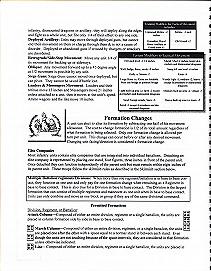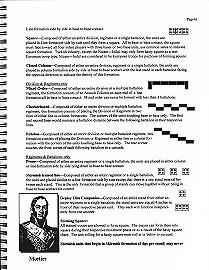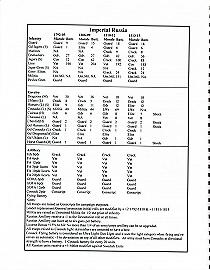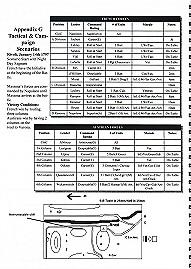
These tabletop miniatures rules are designed "to complete a 50,000 man battle in 4 to 6 hours with a clear decision."
With so many excellent and poor sets of rules out there driven by a variety of people, groups and conventions, it is a challenge just attempting to put out yet another set of Napoleonic Rules. As an avid Napoleonics player, I found that the current popular sets of rules polarized the Napoleonic gaming community into simple one die combats and extensive chart driven detailed rules. What we attempted here is a set of tactical rules that offer the detail of Napoleonics with some fast play mechanisms in an ordered fashion. - Corps Command, Commentary, pg. 171-2 |
Army Groups are organized according to either the European System or the Napoleonic System. European armies are broken into Divisions, while Napoleonic armies may organize their Divisions into Corps.
The period of the Napoleonic Wars offers the historian with information on leaders and formations for the first time in great abundance. Leadership in this period, as in any other, is one of personal character, experience as well as endurance. - Corps Command, Leadership, pg. 10 |
Leaders are given a Character Rating (eight steps, from "Unreliable" to "Superior"), which determines that commander's Activation Number, command radius, and pool of Action Points.
One of the elements that gamers seem to bump into in most miniatures rules sets is the constant "helicopter" syndrome...This set of rules attempts to address the issue by allowing all units that are visible to opposing units to be represented on the tabletop and using a strong command control system. - Corps Command, Command Control, pg. 9 |
Written orders are issued to Corps at the start of the day, and to the Divisions at the start of each Segment, and fall into nine types (Defend, Advance, Attack, etc.). Leaders spend their Action Points to change orders and move units (including formation changes, ordering charges, and deploying/recalling skirmishers). Only units within command radius of a leader can move (except cavalry). Division leaders outside the command radius of their leader must make an Activation Roll (Corps leaders are not subject to this restriction).
Days are broken into 6 or 7 Segments ("Early Morning" to "Dusk"), which are composed of a variable number of Tactical Phases or Turns (determined by dieroll, modified by commander-in-chief rating, weather, supply, army composition, and length of fighting). Each turn is composed of the following steps:
Initiative is rolled once per Segment, modified by leader quality. Some Steps are considered simultaneous, in other Steps the side with Initiative must go first, and in some Steps the side with Initiative has the option of going first or last.


A unit's movement rate depends on its formation, training, and the terrain. Battalions may form:
and may deploy a "skirmish trained line," deploy elite companies, or go prone. Divisions and regiments in addition may form in mixed order, echelon, or checkerboard. Enemy units have a limited ability to conduct "opportunity fire" during enemy movement.
Combat is unit vs. unit., and is not considered simultaneous. The chance to score a hit depends on the troop type of the firer and the range to the target, modified by formation, weather, terrain, and firer's situation (i.e., weapon braced, exhausted, first fire, etc.). A bad dieroll can result in the unit running "low on ammo" (penalty until replenished) or totally out of ammunition; either result will force the unit to retire to the ammunition wagon. A successful hit automatically causes one casualty, and a follow-up Devastating Fire roll may score up to 2 more casualties. (The Devastataing Fire roll is modified due to target formation and firer's training level.) Infantry units may bog down into firefights, becoming locked in place and focused on a single enemy, until rescued by a leader or forced to back down.
EXAMPLE: It is a battle sometime in 1806. A French line infantry unit fires its first volley at a Prussian line infantry unit. The distance is 4" which works out to Short Range, which means our unit (with a typical rating of Crack) has a base chance-to-hit of 60%. This is modified by +25% (first fire), +10% (infantry behind wall, muskets at rest), and -10% (Prussians in light cover), for a final chance of 60 + 25 + 10 - 10 = 85%. Rolling a "58," the French easily score one casualty on the Prussians, and now qualify to make a Devastating Fire attempt. No modifiers apply, so a 10-sided die is rolled - an "8" means an additional casualty. The Prussians end up with 2 total casualties (not enough to force an immediate morale roll). The Prussians must now make a roll to avoid a firefight. A roll of "89" easily avoids the 40% trap - no firefight. Later in the turn, the Prussians take their chance to fire at the French. They are likewise Crack, so again the base chance is 60%. Modifiers are +25% (first fire) and -¼ (French in medium cover). The casualties inflicted previously are not sufficient for a penalty. The final chance is (60 + 25) = 85, minus 25% = .75 x 85 = 64. Rolling "91," the Prussians fail. In fact, the roll is so bad that the unit becomes Low on Ammo. |
At the start of each Segment, artillery units may be assigned to "bombardment." This allows them to fire in the Bombardment phase, firing at all targets within a chosen "bombardment zone." Artillery not on bombardment duty may make attacks as normal. Artillery combat uses the same system as infantry combat, but with a different set of modifiers. Certain nations in certain years have the capability to form a "Grand Battery," melding multiple artillery units into a single super-unit that inflicts double casualties. Rules also cover siege guns, Russian licornes, starting fires, and spiking.
When opposing units clash, the weight of the impact or the mental effect of being charged often broke the sturdiest of lines. Most melees within this period were won during the initial charge to contact and not the physical contact we are so inclined to think. - Corps Command, Impact, pg. 27 |
In order to charge, a unit must be facing and able to see its target, within charge range, in suitable formation, and must belong to a division which has suitable orders. Charge declarations are made at the end of the turn, but are resolved at the start of the movement step. The target of the charge may be forced to check morale, which may result in it routing away. If the charging unit takes casualties before contact, it must test morale, and may be forced to halt, conduct fire combat, then withdraw. Counter-charges are allowed. If the defender stands, and the charging unit carries through, then the two units impact and a melee combat begins.
Opposing units which are in base-to-base contact may conduct melee combat. One side must be the attacker; the other side defends. A unit's melee rating depends on its troop type and number of casualties, with a wide variety of modifiers applying (due to terrain, formation, leaders, opposing troop types, and tactical situation). Each side makes a dieroll, and compares the result to their total melee factors on the Combat Calculator to determine a numerical result. The defender's result is subtracted from the attacker's result to determine the Difference, which indicates one of nine possible melee results. Units may suffer casualties, and be forced to withdraw, rout, or become Disordered; victors may be able to follow withdrawing enemies, or declare a new charge for the next turn. If both units remain in contact, another round of melee combat is immediately fought, continuing until the units are no longer in contact or (if cavalry) until two rounds are concluded, after which the cavalry must break off.
EXAMPLE: It is a battle sometime in 1809. A French "Guard Lancer" cavalry unit desires to charge a unit of Spanish 1st Rate militia in a redoubt. It begins by making its declaration at the end of the turn. At the start of the next movement step, the French have the initiative and resolve the charge. First, the Spanish (being of Militia morale level) must attempt a morale check. The basic chance of failure is 15% (militia morale), modified by +10 (being charged by formed cavalry), for a modified total of 25% chance of failure. Rolling a "27," the Spanish stay and fight. (And if using the optional rules, would become Uncontrolled.) Since the Spanish are still here, they may fire at their attackers. They have a 35% chance to hit at Point Blank range, modified +10% (muskets at rest) for a final chance of 45%. Sadly, the Spanish player rolls a "49." No effect. IMPACT! The cavalry is moved into contact, and is considered the Attacker. The French cavalry, being fresh, have a melee rating of 75. Modifiers are +25 (mounted charging), -25 (attacking heavy cover), -20 (charging uphill), for a final melee value of (75 + 25 - 25 - 20 =) 55. The French roll a "79," which compared against the 55 melee factors on the Combat Calculator, results in a score of "5." The Spanish infantry have a melee starting value (also being fresh) of 45, with no applicable modifiers. They roll "72," which also scores a "5" on the Calculator. The result is a Difference of (5 - 5 =) 0 ... the Arduous Melee! result on the reference card. The instructions call for both sides to take 3 casualties and become Disordered. The attacking cavalry recoil 3" and cannot fire. End of melee. |
Skirmishers consist of those units capable of fighting in skirmish formation, as well as "skirmish companies" issued by a parent unit as a shield.
During the Skirmish Combat Phase, the player with the initiative may make skirmish attacks - and if he doesn't desire to do so and has skirmishers deployed, must make a dieroll to avoid skirmish combat! One attack is resolved per division, rolling a d10 (modified by nationality, year, and the ratio of friendly to enemy skirmishers). The results vary from Suave Que Puet!! to Chased off all opposition.
The human condition; tested to the brink of lunacy when surrounded by hostile cannon and shot. No amount of training can shield man's innate instinct for self preservation. It is a soldier's internal fire and training which will make him steadfast in battle. - Corps Command, Morale Factors & Modifiers, pg. 33 |
Units become Disordered if they move into difficult terrain, take too many fire casualties in one turn, rout, interpenetrate the wrong units, join a disordered unit, break off from melee (cavalry only), suffer Disorder as a melee result, or are close to camels or elephants (also cavalry only). Disordered units move at a reduced rate, can't fire unless in a firefight, and usually cannot charge. Units "regain cohesion" in different ways, depending on how they became disordered, but generally do so during the following turn.
Units may be forced to make morale checks due to combat or situation (i.e., leader killer, nearby units routing, and so forth). Rolls due to combat are made immediately, while other morale rolls take place during the Morale Phase.
Divisions and Corps must check morale once most of their troops have become ineffective. Failing the roll forces an orders change - to Retreat.
Routed units move during the Rout and Rally phase. If undisturbed, a routed unit may attempt a morale check; if successful, it becomes Disordered and is eligible to move on the following turn. However, routing units in the presence of the enemy must make a Pursuit Roll per turn to determine how many additional casualties they suffer (from 1 to 4).
When attempting to recreate the effects of battle on a group of individuals, we decided to use a system that effectively represented several levels of battle fatigue. Brining the effects of confusion, casualties, morale, and the concept of exhaustion into a system that does not require mountains of paper, charts and time was a challenge. - Corps Command, Casualty Factors, pg. 21 |
A unit which takes 5 casualties becomes Tired (combat penalty applies). Each troop type has an Effectiveness rating - when casualties reach this level, the unit becomes Exhausted and must begin an orderly withdrawal. If an exhausted unit suffers additional casualties as a result of melee combat, it disperses and is removed from play.
The maelstrom of combat often shatters a unit's will to follow orders and to take matters in their own hands. Reason or self preservation at times do not matter when motivated by some external force. - Corps Command, Optional Rule for Greater Realism, pg. 34 |
As an optional rule, there is a chance that all but the best troops may become Uncontrolled. Troops which narrowly pass their morale checks are subject to this status, which forces them to charge nearby enemies with great elan.

The rulebook contains extensive appendices with historical information, of application both to the battlefield miniatures rules and to the campaign game. With respect to the battle rules, the data provide:

The rules come with two battle-level scenarios, with force listings, maps, and victory conditions:
The creation of fiction scenarios is covered in the campaign rules, including terrain placement and arrival of forces.
| Last Updates | |
|---|---|
| 19 February 1999 | corrections made |
| 18 February 1999 | page first published |
| Comments or corrections? | |